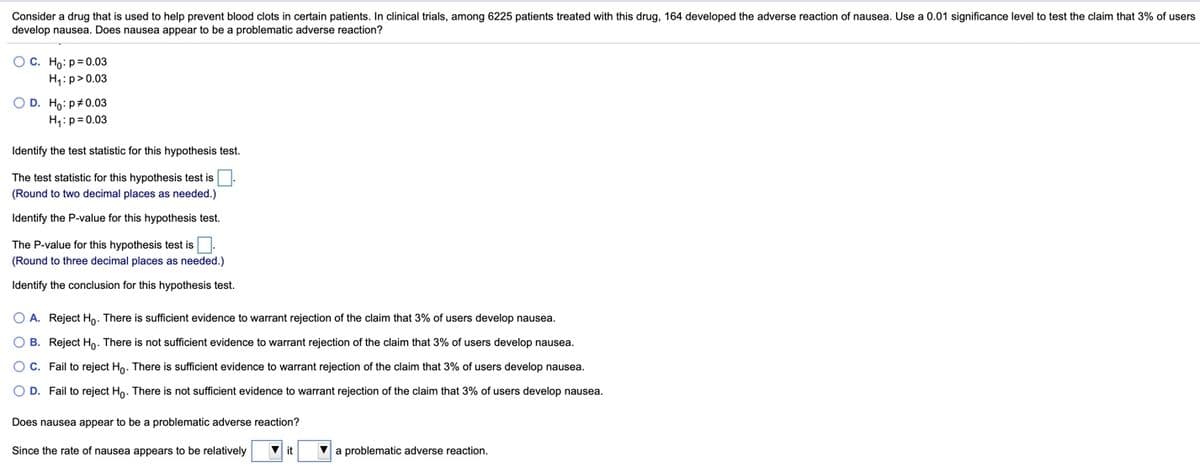Consider a drug that is used to help prevent blood clots in certain patients. In clinical trials, among 6225 patients treated with this drug. 164 developed the adverse reaction of nausea. Use a 0.01 significance level to test the claim that 3% of users develop nausea. Does nausea appear to be a problematic adverse reaction? OC. Ho: p=0.03 H,:p>0.03 O D. Ho: p#0.03 H:p=0.03 Identify the test statistic for this hypothesis test. The test statistic for this hypothesis test is (Round to two decimal places as needed.) Identify the P-value for this hypothesis test. The P-value for this hypothesis test is (Round to three decimal places as needed.) Identify the conclusion for this hypothesis test. O A. Reject Ho. There is sufficient evidence to warrant rejection of the claim that 3% of users develop nausea. O B. Reject Ho. There is not sufficient evidence to warrant rejection of the claim that 3% of users develop nausea. OC. Fail to reject Ho. There is sufficient evidence to warrant rejection of the claim that 3% of users develop nausea. O D. Fail to reject Ho. There is not sufficient evidence to warrant rejection of the claim that 3% of users develop nausea. Does nausea appear to be a problematic adverse reaction? Since the rate of nausea appears to be relatively a problematic adverse reaction.
Consider a drug that is used to help prevent blood clots in certain patients. In clinical trials, among 6225 patients treated with this drug. 164 developed the adverse reaction of nausea. Use a 0.01 significance level to test the claim that 3% of users develop nausea. Does nausea appear to be a problematic adverse reaction? OC. Ho: p=0.03 H,:p>0.03 O D. Ho: p#0.03 H:p=0.03 Identify the test statistic for this hypothesis test. The test statistic for this hypothesis test is (Round to two decimal places as needed.) Identify the P-value for this hypothesis test. The P-value for this hypothesis test is (Round to three decimal places as needed.) Identify the conclusion for this hypothesis test. O A. Reject Ho. There is sufficient evidence to warrant rejection of the claim that 3% of users develop nausea. O B. Reject Ho. There is not sufficient evidence to warrant rejection of the claim that 3% of users develop nausea. OC. Fail to reject Ho. There is sufficient evidence to warrant rejection of the claim that 3% of users develop nausea. O D. Fail to reject Ho. There is not sufficient evidence to warrant rejection of the claim that 3% of users develop nausea. Does nausea appear to be a problematic adverse reaction? Since the rate of nausea appears to be relatively a problematic adverse reaction.
Holt Mcdougal Larson Pre-algebra: Student Edition 2012
1st Edition
ISBN:9780547587776
Author:HOLT MCDOUGAL
Publisher:HOLT MCDOUGAL
Chapter11: Data Analysis And Probability
Section: Chapter Questions
Problem 8CR
Related questions
Question
Practice Pack

Transcribed Image Text:Consider a drug that is used to help prevent blood clots in certain patients. In clinical trials, among 6225 patients treated with this drug, 164 developed the adverse reaction of nausea. Use a 0.01 significance level to test the claim that 3% of users
develop nausea. Does nausea appear to be a problematic adverse reaction?
OC. Ho:p= 0.03
H4:p>0.03
O D. Ho: p#0.03
H:p=0.03
Identify the test statistic for this hypothesis test.
The test statistic for this hypothesis test is
(Round to two decimal places as needed.)
Identify the P-value for this hypothesis test.
The P-value for this hypothesis test is.
(Round to three decimal places as needed.)
Identify the conclusion for this hypothesis test.
O A. Reject Hn. There is sufficient evidence to warrant rejection of the claim that 3% of users develop nausea.
O B. Reject Ho. There is not sufficient evidence to warrant rejection of the claim that 3% of users develop nausea.
OC. Fail to reject Ho. There is sufficient evidence to warrant rejection of the claim that 3% of users develop nausea.
O D. Fail to reject Ho. There is not sufficient evidence to warrant rejection of the claim that 3% of users develop nausea.
Does nausea appear to be a problematic adverse reaction?
Since the rate of nausea appears to be relatively
V it
V a problematic adverse reaction.
Expert Solution
Step 1
164 out of the 6225 people developed the reaction of nausea after taking this drug.
Proportion of people developing nausea =
Better your learning with
Practice Pack
Better your learning with
Practice Pack
Trending now
This is a popular solution!
Learn your way
Includes step-by-step video
Step by step
Solved in 3 steps

Knowledge Booster
Learn more about
Need a deep-dive on the concept behind this application? Look no further. Learn more about this topic, statistics and related others by exploring similar questions and additional content below.Recommended textbooks for you

Holt Mcdougal Larson Pre-algebra: Student Edition…
Algebra
ISBN:
9780547587776
Author:
HOLT MCDOUGAL
Publisher:
HOLT MCDOUGAL

Glencoe Algebra 1, Student Edition, 9780079039897…
Algebra
ISBN:
9780079039897
Author:
Carter
Publisher:
McGraw Hill

College Algebra (MindTap Course List)
Algebra
ISBN:
9781305652231
Author:
R. David Gustafson, Jeff Hughes
Publisher:
Cengage Learning

Holt Mcdougal Larson Pre-algebra: Student Edition…
Algebra
ISBN:
9780547587776
Author:
HOLT MCDOUGAL
Publisher:
HOLT MCDOUGAL

Glencoe Algebra 1, Student Edition, 9780079039897…
Algebra
ISBN:
9780079039897
Author:
Carter
Publisher:
McGraw Hill

College Algebra (MindTap Course List)
Algebra
ISBN:
9781305652231
Author:
R. David Gustafson, Jeff Hughes
Publisher:
Cengage Learning